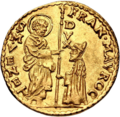Origin
The first reports of Ancona's medieval coinage begin in the 12th century when the independence of the city grew and it began to mint coinage without Imperial or papal oversight. [1] According to some traditions the city began minting currency by concession of the Byzantine Empire, following the fidelity demonstrated during the siege of 1173, which also led to the city's acquisition of its flag of the gold cross on a red field. This story may be doubtful as records for it are late and not supported by contemporary sources. [2]
The coin, also called "Grosso Agontano", was a great success and its type was imitated in other cities of Marche and also in Emilia-Romagna, Tuscany, Lazio and Abruzzo. For example, coins of Massa Marittima, [3] Ravenna, Rimini, Volterra, [4] Pesaro and Ferrara. [5] show a marked influence from Ancona.
This page is based on this
Wikipedia article Text is available under the
CC BY-SA 4.0 license; additional terms may apply.
Images, videos and audio are available under their respective licenses.

